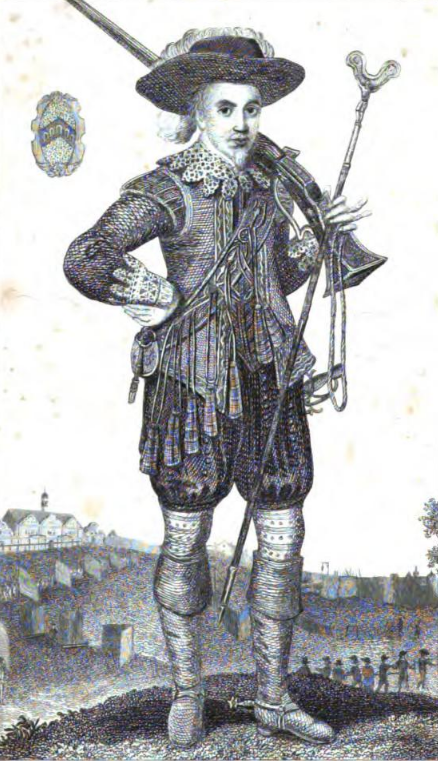Difference between revisions of "MRP: Sir Nicholas Crispe will"
| Line 20: | Line 20: | ||
===Sir Nicholas Crispe, engraving, from a painting, undated=== | ===Sir Nicholas Crispe, engraving, from a painting, undated=== | ||
| + | [[File:ENGRAVING_Sir_Nicholas_Crispe_Anon_HistHammersmith_Faulkner_1839_OpTP_IArch_DL_CSG_270212.PNG]] | ||
| + | ---- | ||
| + | ===Image credits & copyright information=== | ||
| + | |||
| + | |||
| + | 'Sir Nicholas Crispe, from a painting in the Earl of Leicesters collection,' undated, anon, reproduced in Thomas Faulkner, ''The history and antiquities of the parish of Hammersmith'' (London, 1839), op. title page<ref>[http://www.archive.org/stream/historyandantiq02faulgoog#page/n9/mode/2up Thomas Faulkner, ''The history and antiquities of the parish of Hammersmith'' (London, 1839), op. title page]</ref> | ||
---- | ---- | ||
| − | |||
==Transcription== | ==Transcription== | ||
Revision as of 13:03, February 27, 2012
Sir Nicholas Crispe will
Editorial history
27/02/12, CSG: Created page
Contents
Abstract & context
Sugested links
To do
Images
Sir Nicholas Crispe, engraving, from a painting, undated
Image credits & copyright information
'Sir Nicholas Crispe, from a painting in the Earl of Leicesters collection,' undated, anon, reproduced in Thomas Faulkner, The history and antiquities of the parish of Hammersmith (London, 1839), op. title page[1]
Transcription
Notes
Irish adventure, June 1642
"June 1642
[17 June 1642]
Whereas Sir Nicholas Crispe, Knight, Maurice Thompson, Thomas Chamberlaine,[2] Gregory Clement, Richard Waring, John Wood, Richard Shute, George Thompson, William Pennoyer, Thomas Vincent, William Thompson, William Willoughby, Thomas Rainsburrough, Samuell Moyer, and Richard Hill, and their Associates, as well out of their pious and charitable Disposition towards their distressed Brethren His Majesty's Protestant Subjects in the Realm of Ireland, who, being brought into great Misery and Distress, are ready to perish for Want of Relief, as also out of their loyal Respect to His Majesty, and Detestation to that Rebellion, and to reduce the Rebels in the said Realm of Ireland to their due Obedience, and (as much as in them shall lie) to prevent and hinder all such Supplies as shall be sent unto the said Rebels, and likewise, by all possible Ways and Means, to assist and help His Majesty's good Subjects there, and to infest, spoil, and waste the said Rebels by Land and Sea, have lately made known, to the Lords and Commons in Parliament assembled, their voluntary Disposition and Readiness to undertake, by themselves and their Associates, the setting forth and employing of Twelve Ships and Six Pinnaces, with a convenient Number of Land Forces, Horse and Foot (as an additional Increase of their former Adventure), at such Rates and Prices as have been usually allowed for other Ships and Seamen, and formerly entertained by the Lords and Commons, and for such Allowance for Land Soldiers as have been formerly accustomed in other expeditions upon the Sea; which being well approved by the Lords and Commons in Parliament, as a good means to further the reducing of the said Realm of Ireland and the Rebels therein to their due Obedience..."[3]
Possible primary sources
Possible secondary sources
Faulkner, Thomas, The history and antiquities of the parish of Hammersmith (London, 1839)
- ↑ Thomas Faulkner, The history and antiquities of the parish of Hammersmith (London, 1839), op. title page
- ↑ Thomas Chamberlaine, London merchant (sometimes named Major Thomas Chamberlaine. Relative of, and frequent correspondent in the 1660s with, Sir George Oxenden)
- ↑ 'June 1642: 17 June 1642,' in C.H. Firth, R.S. Rait (eds.), 'June 1642: The Ordinance for the Sea Adventure to Ireland.,' Acts and Ordinances of the Interregnum, 1642-1660 (1911), pp. 9-12, viewed 27/02/12
